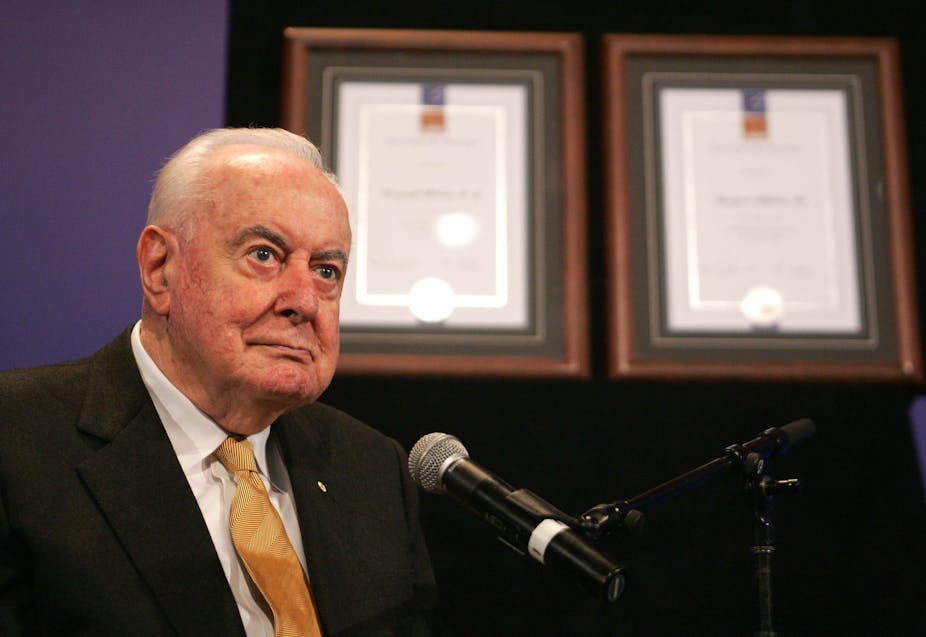There was nothing inevitable about Gough Whitlam’s rise to the top. He had to fight every inch of the way. The fight was not only against born-to-rule Liberals who thought he had betrayed his class but also against dedicated Laborites who had achieved much and weren’t willing to give it away to someone they saw as an opportunist and upstart. Jim Cairns captured this sentiment when in the heat of the battle for party leadership in 1968 he said:
Whose party is this – ours or his?
What Whitlam’s enemies didn’t bargain on was that his politics weren’t based on expediency but rather a well-thought-out vision and strategy for Labor. He was Australia’s version of Tony Crosland, a principled revisionist with a “freedom and equality” agenda that made political and moral sense to the baby boomer generation. Along with an older generation of Labor supporters who were tired of impotence, they became his sword-carriers for party reform.
Fixing party rules and structures
Whitlam took principled revisionism to the very top of Labor politics. He stood up against party officials and their parliamentary supporters who saw the federal parliamentary Labor Party as little more than delegates of the extra-parliamentary party. His victory wasn’t complete – for example, his proposal to give rank-and-file party members a voice in the National Conference wasn’t realised – but he did see to it that the party leader and deputy gained seats.
Whitlam believed in the labour movement and its disciplines, if not all of its practices, but thought that the parliamentary party and its leader needed extra status and the space to exercise leadership if the electorate were to take them seriously.
To have leaders waiting for orders and the parliamentary party impotent to contribute to policy represented a death sentence. What Whitlam sought was balance between the three wings of Labor – members, unions and parliamentarians – and, importantly, between the leader and party officials.
Building a sound policy platform
At the heart of Whitlam’s revisionism was a new and relevant policy platform. He described the 1969 ALP conference as “the most creative and constructive” in its history. It passed 61 resolutions in a wide range of areas and was very much “the program” his office had been developing in the previous five years. Health and education reform were re-affirmed and urban planning came to the table as did land rights for Aboriginals.
Whitlam was able to say in the election of that year that Labor had a plan for the next decade to “renovate, rejuvenate, reinvigorate and liberate”. This was the language the baby boomers loved to hear. When coupled with measures to support workers and their families, it produced increased representation for Labor, but not a majority, in that election. That was to come three years later.
Whitlam’s reforming zeal put Labor at the centre of Australian life where it needed to be if the party was to beat not just the conservatives but also reforming Liberals like prime minister John Gorton and Victorian premier Dick Hamer. He understood that if you aren’t ahead of the pack you are more than likely to be at its rear.
On a number of occasions Whitlam staked his career on the principles of revisionism. He took great risks that some might see as reckless but which history has judged as necessary. In 1966 he was nearly expelled over state aid (seven votes to five) and in 1968 resigned as leader in order to re-contest. He won, defeating Jim Cairns by 38 votes to 32.
Whitlam’s conflicts with Arthur Calwell were legendary, as were those with F.E. (“Joe”) Chamberlain. Whitlam played it as hard as his enemies but he had to in order to bring change. In this context, the comments by Chamberlain in his autobiography are telling:
It was a pity that Whitlam’s stature as a person was diminished by the sometimes brutal, insensitive and unconstitutional means he used to ride to power in the Labor Party. Despite this, he has my deep admiration for being one of Australia’s and one of Labor’s great prime ministers. My argument has always been that unfair means cannot justify the end. Perhaps Whitlam’s fine performance in office is the exception that breaks the rule.
Three lessons for Labor today
What lessons are there in all of this for contemporary Labor? Firstly, that structure and organisation aren’t just means to an end. They are political factors in themselves, sending signals to the community about who is in charge and what they represent.
Secondly, policy matters. Parties can never devote enough time in the search for and refinement of those which can “renovate” and “reinvigorate”.
Finally, political will matters. Risks have sometimes to be taken if progress is to be achieved.

